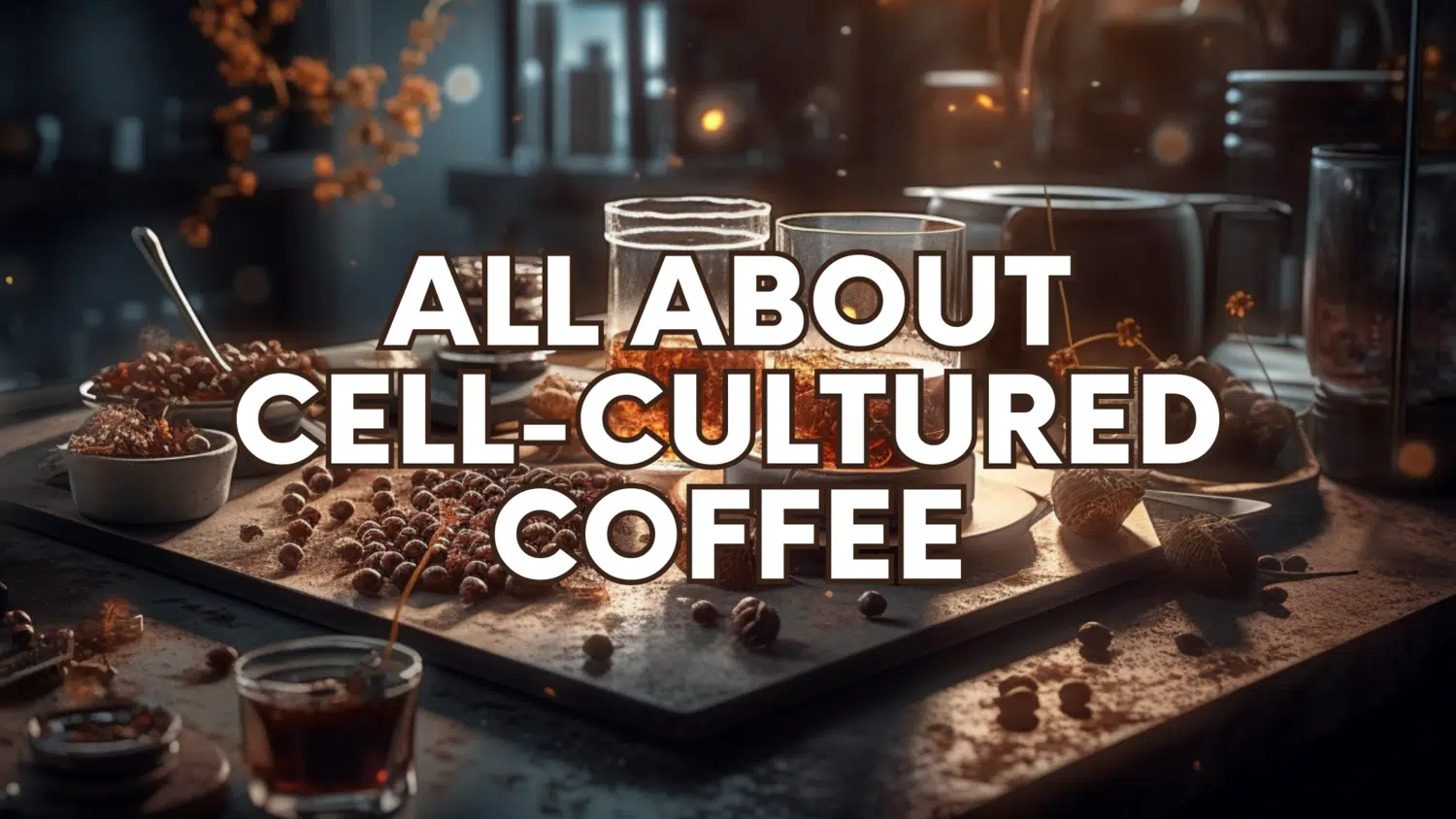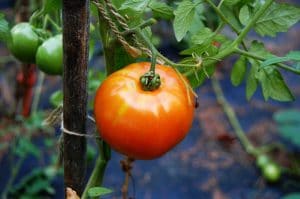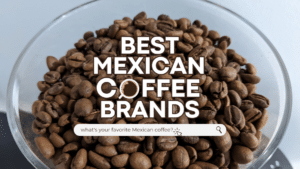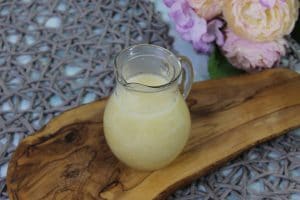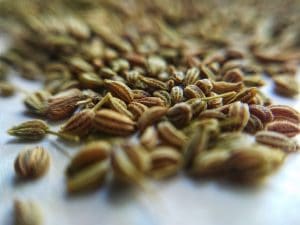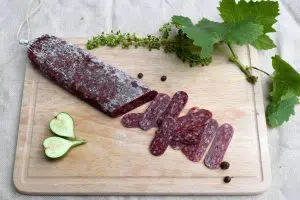All About Cell-Cultured Coffee
Important Note: When you buy through our links, we may earn a commission. As an Amazon Associate we earn from qualifying purchases. Content, pricing, offers and availability are subject to change at any time - more info.
One of the industries home to some of the fiercest competition in the world has seen cutting-edge advancements that appear set to change the future of coffee itself. As the third most popular drink on planet Earth, producers are in a constant struggle to keep up with the rising demand. With worsening economic conditions and increasingly difficult seasons impacting coffee growers, there’s a definite need for a new player in the market. Cell-cultured coffee is the future of coffee production and consumption, offering a sustainable and humane alternative to traditional production methods with the same great taste.
Key Takeaways
- Cell-cultured coffee does not aim to replace traditional coffee but rather supplement the industry. In this way, the future of coffee is prolonged, hopefully to a sustainable point, instead of suffering under worsening conditions leading to the current risk of extinction.
- To many, cell-cultured coffee and even upcycled molecular coffee are considered disruptors within the industry. Whether or not one sees plant cultures as a savior to everyone’s favorite beverage or a threat sucking money from global coffee is a personal decision. Still, one thing is for sure, lab-grown coffee is coming, and it looks set to stay.
- Key Takeaways
- What is Cell-Cultured Coffee?
- The Taste Test – How Cell-Cultured Coffee Compares To Regular Coffee
- The Future of Cellular Agriculture & Cell-Cultured Coffee
- Cell-Cultured Coffee Brands
- Cell-Cultured Coffee – Frequently Asked Questions
What is Cell-Cultured Coffee?
Cell-cultured coffee is the latest breakthrough development in cellular agriculture. The endeavor aims to deliver lab-based bioreactor-grown coffee derived from actual coffee using cellular culturing techniques just without the rising costs or environmental burden of traditional production methods. Coffee cell culturing, also colloquially known as lab-grown coffee, could revolutionize the coffee industry by creating a more sustainable and eco-friendly way to produce coffee. With traditional coffee production relying on intensive farming techniques that often lead to deforestation, soil degradation, and pollution, the need for a more sustainable option is greater than ever.
The Taste Test – How Cell-Cultured Coffee Compares To Regular Coffee

While estimates place commercially available cell-cultured coffee many years away, a VTT Technical Research Centre testing panel determined that the initial brew is very similar to regular coffee. VTT Research team leader Heiko Rischer explains that samplers find it to taste like a blend of different coffees instead of one particular type like Arabica or Robusta. It looks, tastes, and smells similar to coffee, but emulating the full depth of flavor of authentic coffee identically and scaling this production are the true challenges faced by the industry.
How Cell-Cultured Coffee Is Produced
Cell-cultured coffee is produced using cellular agriculture techniques, unlike molecular coffee which is made from a combination of upcycled ingredients derived from non-coffee plants. To produce cell-cultured coffee, a sample of coffee cells is first taken from a coffee plant and grown in a nutrient-rich liquid medium in a bioreactor. Only the best cells are selected for their ability to produce the desired flavor and aroma compounds, which are key to replicating the taste of traditional coffee.
The primary culture of cells is achieved by taking a small portion of the plant and placing it on a medium containing various nutrients and hormones to stimulate division and reproduce a large collection of cells. The liquid medium for growth is a solution typically containing coffee leaf callus, coffee leaves, and orthotropic shoots blended with rich nutrients like sugars, amino acids, vitamins, and minerals.
After the cells are established as cultures within a lab (think Petri dish), they are then injected with microbes and grown in a bioreactor which forms a harvestable biomass through a process of controlled fermentation with near-equal properties produced to conventional coffee beans. The bioreactor is basically a closed steel tank that facilitates controlled and rapid fermentation. One can imagine the growing cellular coffee as a mass of fermenting liquidity plant matter,
When the biomass grows to a similar consistency of a slushy, it is then dried and roasted in a similar manner to coffee beans. In terms of smell and taste after processing and brewing, cell-cultured coffee is very similar to regular coffee, but when it comes to its initial appearance in raw form, the two start off as very different products.
Benefits Of Cell-Cultured Coffee Over Traditional Coffee Production
As the world becomes more aware of traditional food production’s environmental and animal welfare impacts, alternative methods are being developed to meet the needs of a growing population while mitigating the impact on the planet. Cell-cultured coffee is one of the most promising developments that have the potential to revolutionize the coffee industry by offering a sustainable and cruelty-free alternative to traditional coffee production. Let’s take a closer look at the difference in impact between regular and cellular coffee.
Immensely Faster Harvesting
Traditional coffee plants take three to four years before they can be harvested, with one annual harvest each year thereafter. In comparison, cell-cultured coffee can regenerate plants from cells in just nine to ten months. Furthermore, coffee growers face a 28-year average breeding cycle to cross-breed and develop a viable improved product with better yield while battling pests and environmental variables throughout. This lengthy process delays the impact of any molecular biology techniques used to improve growth rate, flavor, plant hardiness, or harvest capacity. It is widely known that cell-cultured coffee takes two weeks or less on average from cell culturing to drying, roasting, and grinding. Some leading companies pull off mere days.
Cellular Coffee Can Be Grown Anywhere
Generating coffee cell cultures can occur in any region instead of being constrained to the current geographical limitations of the bean belt resulting in lower transport cost and reduced pricing in general. The bean belt is a region located between the Tropics of Cancer and Capricorn that provides the ideal climate for growing coffee. This region’s climatic conditions confine the cultivation of coffee to specific areas, resulting in a limited supply and higher prices for certain types of coffee. The limitations are further exacerbated by climate change, which has altered the weather patterns and led to more extreme weather events over recent years, including droughts, floods, and heat waves. This, in turn, has resulted in a decrease in the quality and quantity of coffee crops, affecting the global coffee industry. It’s predicted that the areas suitable for coffee production will decrease by 50% by 2050, resulting in a significant loss of jobs and income for the estimated 25 million coffee farmers worldwide.
Zero Use Of Fertilizers
Coffee production uses chemical fertilizers that contain high levels of nitrogen, which can easily leach into nearby water sources through soil runoff or subsurface drainage. This creates an excess of nutrients in the water, leading to the overgrowth of aquatic plants that deplete the oxygen supply in the water, causing the death of fish, shellfish, and other organisms. The nutrient-rich water promotes the growth of harmful bacteria and pathogens, leading to the spread of diseases that can have devastating effects on the aquatic ecosystem, disrupting the food chain and leading to the decline of other species.
Absolutely No Pesticides
One of the significant benefits of cellular coffee is that it can be grown without the use of pesticides, which is prevalent in traditional coffee growing and production. Pesticides are known to contaminate soil and water sources and negatively impact the health of farmworkers and nearby communities. In addition, residue from pesticides can affect the quality of the coffee, leading to a less desirable taste and aroma. Cellular coffee, on the other hand, can be grown in a controlled environment, eliminating the need for pesticides while the nutritional content and quality are optimized.
No Trees, No Deforestation
The $10 billion coffee industry has devastating environmental consequences, including massive deforestation, soil erosion, and water pollution. Every cup of sun-grown coffee destroys one square inch of rainforest, which decreases the moisture in the air, alters soil composition and foliage, and alters the balance of organisms in the soil ecosystem. The widely used practice of burning forests and tilling the land changes the temperature of the land area and the chemical composition of the soil, leading to a warmer and drier land with an altered balance of organisms, unable to support the same equilibrium of plants and organisms.
Bioreactor Growth Eliminates Soil Erosion
Soil erosion is a major concern in coffee production, especially in deforested areas, causing the loss of valuable organic soil components, including soil carbon, which affects soil health and productivity. In temperate zone agriculture, the organic matter vital to plant nutrition depletes very quickly during the initial 25 years of coffee cultivation. However, in tropical soils, such losses can occur much faster, sometimes within just five years after conversion, due to low organic matter and high temperatures and rainfall. Soil erosion reduces fertility and crop yields, which could have significant economic implications for the estimated 100 million coffee farmers worldwide.
Prevent Coffee Extinction
Coffee biodiversity is currently in a critical state. In 2019, the Union for the Conservation of Nature (IUCN) found in 2019 that at least 60% of all global coffee species are at risk of extinction due to factors like deforestation, climate change, and the intensification of coffee production, which threatens not only the supply of coffee but also the survival of various plant and animal species that rely on coffee plants for their livelihood. 28% of threatened coffee species are growing in areas without any form of ecological protection, which worsens their extinction risk. The loss of these coffee species has significant cultural and economic impacts on local communities that have relied on them for centuries for medicinal and cultural purposes.
The Future of Cellular Agriculture & Cell-Cultured Coffee
Cellular agriculture techniques are allowing food scientists to shape the exact form, nutritional value, and flavor of countless different types of food without widespread damage to economies or the environment. Cultivated beef has settled from an initial cost of $280,000 for the first burger patty to mere dollars today and experts are confident that price equivalency across-the-board will be reached in a matter of years. The focus is also expected to shift away from merely matching flavor and volume but rather raising the nutrient content of cell-cultured coffee and other plant cell cultures.
Cell-Cultured Coffee Brands
There are only a limited number of cellular agriculture firms working on cell-cultured coffee, but these trailblazing companies are laying out a path for a future for coffee that lowers the environmental impact and costs and promotes greater sustainability. Keep a close eye on the following cellular coffee brands.
VTT Technical Research Centre
The most talked about development in cell-cultured coffee is the breakthrough made by the VTT Technical Research Centre, which is a part of VTT CellularFoods in Finland. In September 2021, VTT successfully established coffee cell cultures and then grew them in a bioreactor using a process of controlled fermentation. After processing which basically spanned drying and roasting, granules with a similar appearance to instant coffee, just denser, were produced. While still several years away from retail in the US, the event has sparked global interest in cellular coffee, which will most likely bring competing local brands to our shelves much sooner. VTT CellularFoods has several exciting cell-cultured foods in development.
All the company now needs is eager investors ready to take these cellular foods to retail. Cell-cultured egg whites are already possible and the company is renowned for growing endangered Nordic berries from cultures. Furthermore, the VTT cultures collection has plant cultures for the following foods available to order, namely Avena (Oats), Betula (Birch), Catharanthus (Madagascar Periwinkle), Cochleariam (Scurvy Grass), Conium (Poison Hemlock), Empetrum (Crowberry), Fragaria (Strawberry), Hordeum (Barley), Hyoscyamus (Henbane), Nicotiana (Tobacco), Petit (Parsnip), Plumbago (Leadwort), Rhazia (Hemp Nettle), Rubus (Blackberry/Raspberry), Sorbus (Mountain Ash), Vaccinium (Blueberry/Cranberry), and Veratrum (False Hellebore).
Minus (Formerly Compound Foods) From Cult Food Science

The Canadian company Cult Food Science launched Cult Foods in 2022, which will be delivering a series of cell-cultured foods. So far, the brand has two companies under its umbrella, namely Minus, which makes cellular coffee, and Free Candy, making gummies using cellular gelatin. The Seattle-based beanless coffee company Minus Coffee opened in 2020 with the brand name Compound Food, and by 2021, the brand saw a redesign to Minus and its first product launched. Coffee Minus The Beans is Minus’ first beanless coffee blend and the only cell-cultured coffee that US consumers have been able to try out first-hand.
The cold brew coffee sold in a can is grown using cell culturing and fermentation in a bioreactor, but unlike VTT’s initial development, which is made from coffee byproducts and cells alone, Minus has opted for a combination of chicory, date seeds, grape seeds, carob, lentils, and sunflower seeds. It didn’t take long for the initial batch of Coffee Minus The Beans to sell out at $5 a can via the company’s website. With 100 mg of caffeine per 8.4 oz can, it’s stronger than your average iced coffee, and given the reception, customers can’t wait to see stocks readily available. Be sure to preorder or add yourself to the mailing list to be updated on new developments.
California Cultured
California Cultured is a cellular coffee and chocolate developer headquartered in Davis, California. It took two years after being founded in 2020 to reach a point of significant development, but the company appears set to be one of the first cell-cultured coffee sellers in the US. In April 2022, following the publication of the COSMOS Trial (COcoa Supplement and Multivitamin Outcomes Study), which highlighted the immense cardiovascular benefits of cacao supplementation, California Cultured began sharing successful culturing of coffee and cocoa from cells to roasting in just four days. There are no details on where to buy yet, but the brand’s Instagram is buzzing with activity, so be sure to keep your eyes on this one. The decadence literally drips off each photo of cell-cultured chocolate in the making.
Stem
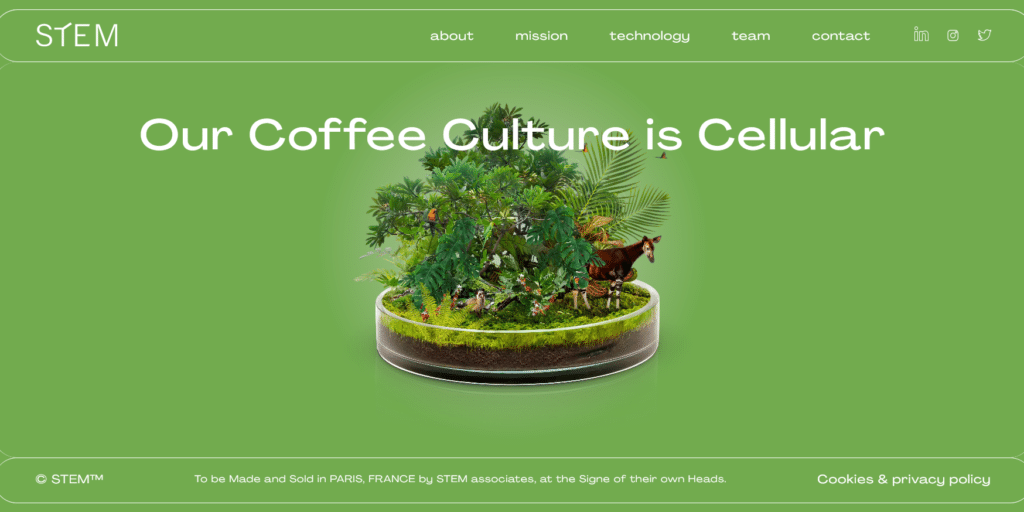
The French Cellular Agriculture company STEM based in Paris, has been globally recognized for its early-stage cell-cultured coffee developments. STEM extracts stem cells from coffee plants alone and then propagates, grows, dries, and roasts green coffee cultures. All STEM products are developed exclusively from coffee and coffee by-products and no other ingredients. Both cold-brewed and canned coffee are in development. So far, STEM has successfully and sustainably produced green coffee powder in a lab. STEM stated in a 2023 press release on LinkedIn that the company expects its cell-cultured coffee to be available in regular retail markets within just three years.
Molecular Coffee
While also created using cellular agriculture, molecular coffee doesn’t actually contain any coffee by-products or coffee-derived cell cultures. Instead, an exact balance of precise upcycled food waste is fused together into a new product using fermentation and then roasted and ground into a product that smells and tastes like coffee. At the time of writing, the US had one molecular coffee brand available – Atomo Coffee.
Atomo Coffee

Atomo Coffee is the forerunning pioneer in molecular coffee in the USA. The Seattle-based beanless coffee company doesn’t use coffee at all to create its coffee but instead weaves together a fusion of over 1,000 flavor and aroma molecules, effectively reengineering coffee beans. What this basically means is that Atomo upcycles, or rather ferments, several types of plant waste together in a bioreactor to arise at its product that looks and tastes almost identical to coffee, just with a fraction of the carbon footprint of any other cold brew. The best part? Atomo is readily available to order in three flavors, Classic Black Cold Brew, Ultra Smooth Cold Brew, and Oat Milk Latte right now.
Cell-Cultured Coffee – Frequently Asked Questions
If there’s anything you’re uncertain about concerning cell-cultured coffee and beanless coffee brands, here are the answers you’re looking for.
Cell-cultured coffee, also known as lab-grown coffee, is produced by growing coffee cells in a controlled environment without the need for soil, water, or pesticides. The process of producing cell-cultured coffee involves taking cells from a coffee plant and then culturing them in a nutrient-rich medium, allowing them to grow and multiply. Molecular coffee is produced by synthesizing the compounds that give coffee its flavor and aroma in a lab. The process involves isolating the individual molecules that contribute to the flavor and aroma of coffee from food waste. These molecules are then combined using cellular agriculture techniques similar to cell-cultured coffee to create a coffee-like beverage.
As a product derived entirely from plant-based ingredients using a natural process of fermentation, cell-cultured coffee is completely safe to drink. The base components granting the flavor, aroma, body, and acidity are exactly the same as regular coffee. Unfortunately, at the time of writing, laboratory-grown coffee is classified as experimental food and requires FDA approval in the US before it can be sold. In the UK, Novel Food approval is also pending prior to launching cell-cultured coffee products.
Molecular coffee is produced by synthesizing the coffee flavor molecules from scratch using various chemical reactions between upcycled food waste, while cell-cultured coffee is produced by growing coffee cells in a controlled environment to produce coffee without the need for coffee plants.
There are very few cell-cultured coffee brands currently available. This means that the few found globally are selling for a very high price. For example, molecular coffee brand Atomo which isn’t anywhere near as cost-intensive as cell-cultured coffee, retails for approximately the same price as four cans of Starbucks cold brew. As production increases and more products enter markets, costs are likely to come down immensely. For now, sample a new brand from our wrap-up of the best coffee brands on Amazon. You’re sure to find a new favorite.
